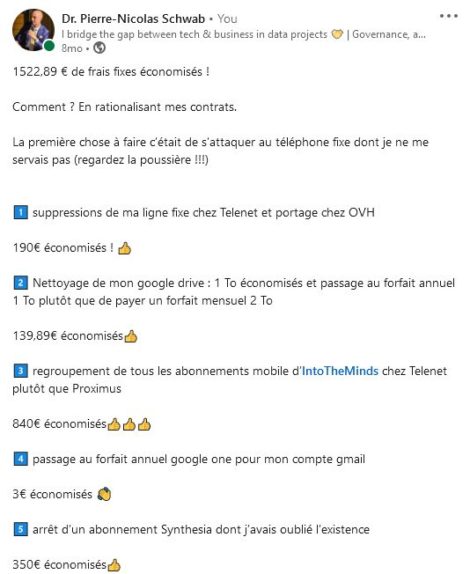For those still in doubt, a major recession will hit the world. It could well turn into a depression worse than the one in 1929. Preparing for a recession is a matter of survival for companies. This article proposes 9 concrete actions to prepare for the recession. Far from being a theoretical article, this guide combines the actions we are already implementing at IntoTheMinds.
Contact us if you have any questions
Summary
- The 3 main principles of survival in a recession
- 5 concrete actions to minimize costs in times of crisis
- 4 concrete actions to maximize revenues in times of recession
If you only have 30 seconds
- In a recession, you need to make your company as “agile” as possible so that you can react quickly when the going gets tough. Follow these 3 principles:
- Reduce your debt
- Turn your fixed costs into variable costs
- Increase your profitability
- To increase your profitability, you must act on your revenues and costs
- 5 concrete actions to reduce your costs:
- Switch from SEA (paid advertising) to SEO (free organic results)
- Terminate your lease and move to coworking (if your activity allows it)
- Terminate subscriptions that have not been used for more than 60 days
- Rationalize your expenses by applying the Pareto principle (we saved 1522,89€ per year)
- Identify exchange rate-sensitive costs and find alternatives
- 4 concrete actions to increase your revenues
- Eliminate the least profitable customers
- Eliminate the least profitable products
- Use inbound marketing to find additional qualified leads
- Hunt for public markets
How do you minimize costs in times of crisis?
Surviving a recession requires fine-tuning your cash flow. It is the essence of the war. To achieve this, here are 3 main principles to follow:
- First of all, you must reduce your debt (or at least not increase it) so that you are not at the mercy of the banks. It is a question of survival. It is therefore essential not to take out any loans. The period of inflation and rising interest rates does not lend itself to this.
- Then, you have to eliminate your fixed costs and make them variable. This will give you flexibility and allow you to react faster.
- Finally, you need to increase your profitability by all means. At constant perimeter (i.e., without increasing your payroll), the 2 adjustment variables available to you are
- costs
- revenues (sales)
In the rest of this article, we give you solutions to minimize costs and maximize your revenue.
How do you minimize costs in times of crisis?
1/ Replace online advertising (SEA) with SEO
One of our customers was spending 20% of his turnover on Google AdWords, that is to say, nearly 150.000€ per year. Advertising, although crucial, has a cost. Every Euro spent on SEA (Search Engine Advertising) will be missing from your bottom line at the end of the year. You can often replace advertising with SEO (Search Engine Optimization) at zero cost. Organic results offer you free natural exposure in search engines. If you want more details, do not hesitate to contact us.
2/ Terminate your lease and switch to coworking
The coworking solution can be interesting for small teams and service companies. As energy costs increase, switching to a coworking solution where everything is included (electricity, heating in winter, air conditioning in summer) can be a good choice. Moreover, you may have to let go of some employees in a recession. In this case, it is better to have a flexible solution rather than a fixed rent for an office space that would become too large.
In our case, we pay about 250€ excl. VAT per month per employee. This is unbeatable.
3/ Get rid of unnecessary subscriptions and discounts
A simple rule of thumb: if you haven’t used one of your subscriptions in the last 60 days, your company doesn’t need it. Delete it and re-subscribe for 1 month when the time comes if you really can’t do otherwise.
If you need a subscription service, here are 2 tips to save up to 50%:
- If you are already a subscriber, let the subscription expire and wait for the website to send you a re-subscription offer. 9 times out of 10, they will propose a discount.
- If you are not yet a subscriber, look for discount codes (type the name of the service followed by “discount code” in google). If you can’t find one, ask the company for one! Our attempts have been successful in 50% of the cases.
4/ Apply the Pareto principle to your expenses
80% of a company’s expenses are generated by 20% of its suppliers. Based on the Pareto principle, it is in your best interest to do the exercise with your accountant and to find alternative solutions. By the end of 2021, we had done the exercise and saved 1522,89€ per year!
4 simple ideas to limit your expenses
- Terminate your landline or replace it with a virtual line
- Clean up your Google Drive and switch to an annual plan
- Remove unnecessary subscriptions (see above)
- Replace paid solutions with free ones whenever possible
5/ Identify the most currency-sensitive costs
It will not have escaped your attention that the dollar has risen sharply against the Euro. The latter has lost 20% in the space of a few months. The consequence is simple. Everything you buy in dollars now costs you 20% more.
Identify on your bank statement the lines in foreign currency (the conversion rate is written next to them). If these lines are recurring, look for European alternatives.
At IntoTheMinds, we do over 100 recurring transactions per year in Dollars and have found Euro alternatives for half of them.
How do you maximize revenue in a recession?
En période de récession il faut maximiser votre chiffre d’affaire par rapport à votre masse salariale. En d’autres termes, il faut rentabiliser les heures de vos employés au maximum. Toute optimisation commence par un calcul du chiffre d’affaires généré par employé.
1/ Eliminate the least profitable customers
Some customers are more profitable than others: these are loyal customers. They require less work (because the trust is already there). In his book “The 4-hour work week,” Tim Ferriss tells how he increased his profitability by keeping only 7 customers out of 100. It may be counter-intuitive, but this recipe we applied to one of our customers (ProDegustation), and it worked.
2/ Eliminate the least profitable products
You must also focus on your most profitable products to maximize your profitability. For a service company, these services bring you the most revenue in relation to the amount of time they require.
The method is called ABCosting (for Activity-Based Costing) to realize product profitability research. This analytical method makes it possible to identify the associated activities for each product or service. This exercise, although complex, is always full of surprises.
3/ Seek additional customers through inbound marketing
Let customers come to you rather than spending money chasing them. That’s what inbound marketing is all about. Our market research agency has been using inbound marketing for 10 years. This allows us to have no salesperson and to receive only 100% qualified requests.
4/ Hunt for government contracts
Public markets are often frightening and sometimes go unnoticed due to a lack of knowledge. Yet they are an inexhaustible source of business. The first thing to do is to identify the national websites where public procurement is published. Focus on your national market first. Here are some national websites to start your search:
- France: https://www.marches-publics.gouv.fr
- Belgium: https://www.publicprocurement.be
- Italy https://www.agid.gov.it
- Spain: https://contrataciondelestado.es
- The Netherlands: https://www.tenderned.nl
- Luxembourg: https://marches.public.lu
- Germany: https://www.evergabe-online.de
So, there you have the advice we can provide. This is going to be a very difficult period. But as always, crises are also opportunities. If you want us to help you seize them, do not hesitate to contact us.
Posted in Strategy.



